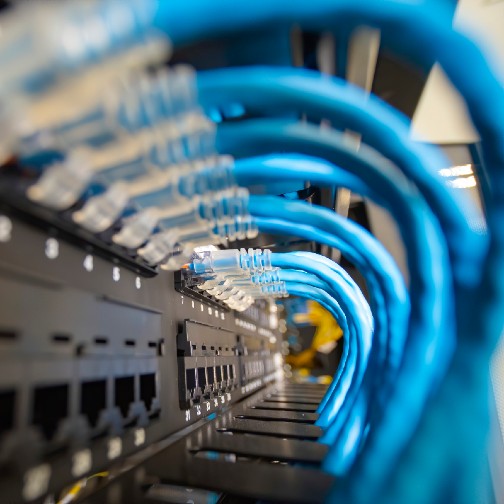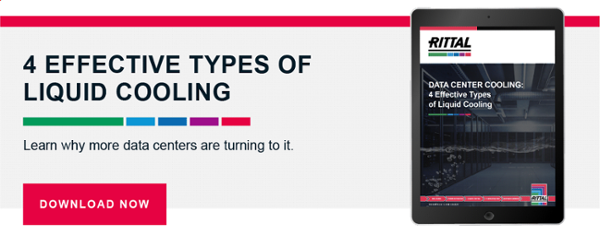4 Applications that Benefit from LCP DX-Based Liquid Cooling
Liquid cooling of IT equipment, now at the row level instead of for an entire white space, is gaining momentum in the distributed data center world, where the demand for efficiency in cooling higher density racks is making IT professionals rethink their reliance on traditional methods. Various liquid cooling technologies – direct-to-chip, immersion, direct expansion and others – are winning favor in the different IT spaces. Why? Because they bring heat removal closer to the equipment, require little if any changes to infrastructure, and are easy to scale as demand grows; when you need to add more racks, additional cooling capacity is achieved with the cooling systems supporting increased IT enclosures.
Read Here: Data Center Cooling-The Best Methods for Different Needs
Liquid cooling is especially advantageous for small and medium-sized businesses that have on-premise servers mounted in one or more enclosures. Many of the IT professionals supporting these organizations are forced to put these in some remote, out-of-the-way space within the building, assuming (wrongly) that as long as the building's HVAC system has a vent terminating in that room, cooling the equipment won’t be a problem.
But we’ve seen that “comfort cooling,” which is the job of a facility’s HVAC system, isn’t adequate for server rack cooling and the demands of heat-generating IT equipment. Those demands are non-negotiable: precise temperature and humidity control, and proper airflow to get the heat away from the equipment.
Focusing on just a few different market sectors can illustrate the demands of the new IT environment. Hospital & healthcare, schools, factory floor, distribution centers are all examples of the types of organizations and facilities often forced to utilize spaces never intended to support the climate control needs of IT equipment: unused offices, janitors’ closets, corners of basements, etc. And because all rely on data to run their businesses, they’re all at risk of system failure because they aren’t addressing the critical climate needs of their IT investments.
Enclosure Climate Control in Hospitals
Data is critical in ensuring quality patient care and the smooth, efficient performance of even the smallest healthcare facilities. Hospitals, clinics and physician practice groups rely on IT equipment to store and transfer data among departments, achieve operational efficiency and maintain compliance using enterprise resource planning (ERP) systems. Without proper temperature, humidity and airflow control, the IT equipment that processes and stores necessary data could fail, and the cost of downtime and potential lost data is immeasurable. There is also extremely limited space to place these systems; after all, the main business of a hospital is patient care, not IT. Especially today in the midst of a global pandemic, healthcare facilities must maximize space for their patients, not their IT appliances.
Data Center Cooling in Education/School Campuses
What happens when a school’s “comfort cooling” system can’t keep up with all the heat being generated by the server room’s IT equipment (if they are lucky enough to even have such a space)? These systems are intended to keep humans comfortable, not maintain the precision and optimal air flow needed to remove heat generated by the IT equipment. Schools rely on IT equipment to help maintain productivity, organize data, and reduce time and effort of work that would otherwise be manual. Servers and processors enable insights that help administrators allocate the right resources to the right areas at the right time, connect campuses and departments, and speed communication between students, teachers, administrators and parents. And as with the healthcare sector, COVID-19 has placed enormous demands on bandwidth and compute capability as school systems have become virtual classrooms supporting remote learning applications and programs. This means more equipment, more heat, and less available installation space.
Server Rack Cooling in Manufacturing
Manufacturing facilities represent some of the most uncontrolled environments in which to place IT equipment. Wide temperature ranges, dust, debris, moisture and corrosive elements are all enemies of smooth factory floor operations, and because there is often no dedicated IT room (or at least one designed for IT), the risk of equipment degradation and failure is very real. Manufacturing organizations rely heavily on manufacturing execution systems (MES) and ERP systems for visibility into all aspects of the supply chain and production, and for seamless integration between the shop floor and Billing, Sales, Operations, HR and other departments.
Climate Control Units in Distribution
Distribution warehouses are notorious for having subpar climate control: they’re often either too hot or too cold; when air conditioning is running, cold air is “dumped” to the floor and doesn’t mix with warmer air near the ceiling (and the opposite situation when the heat is running); air flow throughout the building is almost impossible to control; and air leaks from the inside to outside and vice versa are common. Imagine, then, the effect of a poorly controlled climate in a small room where heat is being generated.
Like manufacturing, warehousing and distribution rely on up-to-date information about inventory, customers (through a CRM tool), fleet management, marketing, shipping and more. When equipment is compromised by temperatures that are too high (and in some cases too cold), all the data that’s used to ensure optimum facility and system performance is at risk for failure.
The best solution for cooling racks for these types of organizations is one that’s similar to a building’s own AC – one that uses direct expansion (DX). Heat removal is achieved with a compressor / condenser refrigeration cycle to reach and maintain a setpoint temperature and humidity level but that is designed to work at the cabinet (sometimes called enclosure) level.
Rittal’s DX-based solution (part of the Liquid Cooling [LCP] family of products) is ideal for businesses, like those above, that have “mission-critical” data needs but less-than-ideal data room options. The close coupled LCP DX 20kW provides a single or multiple IT enclosures with up to 20kW heat removal capacity, available in both closed loop rack and open loop inline options. Some of the benefits of this solution include:
- A small footprint, making it appropriate for nearly any location within the building
- Precise temperature and humidity control that responds to varying equipment heat loads
- Local climate control – airflow is provided to one or more cabinets in a closed system, or cooling to the entire space in an open airflow configuration
- Simple maintenance – tool-less fan replacement, easy-to-access electrical connections and remote notification of all operational parameters
- Redundancy – up to 8 units can be interconnected, with coordinated air flow, alarms, and time-of-day operation
- Reduce the need for a dedicated room to support IT equipment. With proper planning and physical security, it is possible to place these systems out on the floor or shared space. The costs to build and maintain a dedicated IT room are eliminated
Today, every organization, no matter the size or industry, relies on optimum IT equipment performance in order to meet its ongoing operational demands. If yours is putting rack cooling needs at the mercy of your building’s HVAC system, the risk of system downtime is very real, and the potential cost to operations significant. The best protection against system failure is to utilize IT cabinets with liquid cooling capabilities that offer precise control of temperature, humidity and airflow – all critical factors when it comes to ensuring that your organization’s work is never disrupted.




